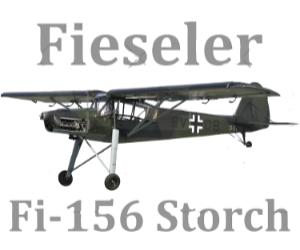 |
|
| Storch in flight at Flying Legends (July 2012) | |
| Role | Reconnaissance & communications |
|---|---|
| National origin | Nazi Germany |
| Manufacturer | Fieseler Morane-Saulnier |
| First flight | 24 May 1936 |
| Introduction | 1937 |
| Retired | Germany: 1945France: 1970 |
| Primary users | Luftwaffe French Army French Air Force |
| Produced | 1937–1949 (-1965 as the MS 500) |
| Number built | Over 2,900 |

The Fieseler Fi 156 Storch ([ʃtɔrç], "stork") was a liaison aircraft designed and produced by the German aircraft manufacturer Fieseler. Its nickname of Storch was derived from the lengthy legs of its main landing gear, which gave the aircraft a similar appearance to that of the long-legged, big-winged bird.

During the Second World War, the French manufacturer Morane-Saulnier was operated under German control, during which time it built a number of German types including the Storch. Immediately after the liberation of France in 1944, the production of the Fi 156 at the Morane-Saulnier factory was continued at the request of the Armée de l'Air. The resulting batch of aircraft produced with the remaining stock of Argus air-cooled inverted V8 engines were designated MS 500 Criquet. Aircraft with further modifications and different engines (inline and radial) received various different type numbers. The use of the aircraft in Indochina highlighted the weakness of wood for the construction of the airframe; thus it was decided to build the wings out of metal instead. Among the modifications, the defensive weapon aiming through the back window was dropped, although some aircraft were modified in the field to take a MAC 34T machine gun firing through one of the side windows. Some 141 aircraft were built before the end of the Second World War while a total of 925 aircraft were built before the end of the production of all types of Criquet by Morane-Saulnier in 1965.

Ceiling
MAX RANGE
Aircraft Speed
Max Crew


Both the French Air Force (Armée de l'Air) and the French Army Light Aviation (Aviation Légère de l’Armée de Terre) operated the Criquet between 1945 and 1958. Accordingly, the type saw battlefield service in French hands during both the Indochina War and the Algerian War.
The Swiss Air Force, as well as several other European countries, continued to use the Storch
The Swiss Air Force, as well as several other mountainous European countries, continued to use the Storch